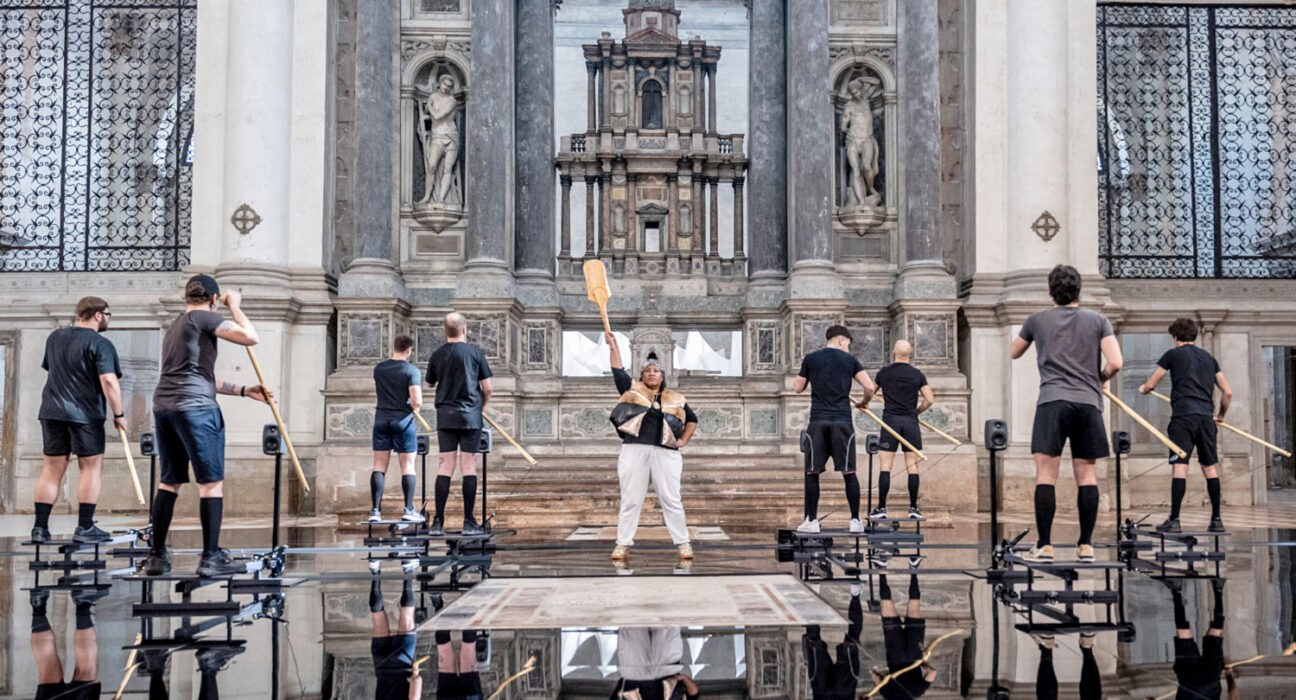It wasn’t enough for Francesca Thyssen-Bornemisza to build a world-class art collection. That had been done by generations of the Thyssen family before her—most notably her father, the Swiss industrialist Baron Hans Heinrich Thyssen-Bornemisza, who amassed a vast collection of old and modern masters, widely regarded as one of the finest in the world.
She wanted something more from her art patronage, envisioning her life’s work as an instrument for activism, particularly climate activism. She found her calling by launching her TBA21 foundation in 2002 with the express purpose of commissioning, producing, and exhibiting contemporary works that engage directly with climate and social justice. Henceforth, environmental causes would inform her collecting.

Francesca Thyssen-Bornemisza with Walid Raad’s Epilogue VIII: The Crates (2021), commissioned by TBA21. Photo: Diana Andrunyk. Courtesy of TBA21.
“I wanted to contribute to more regenerative and just life on this planet,” she told me. “At TBA21, we develop artistic projects that address urgent social and environmental challenges and, very often, imagining alternative futures worth fighting for. The artists we work with bring their own activist practices into their projects, challenging viewers to grapple with complex ideas and emotions.”
Olafur Eliasson and David Adjaye, Your Black Horizon (2005), Lopud, Croatia, 2014. Commissioned by TBA21. Photo: Zoran Marinović. Courtesy of Francesca Thyssen-Bornemisza.
Just a few of the environmentally conscious artists she’s commissioned include Olafur Eliasson, Tomás Saraceno, Sharon Lockhart, Carsten Höller, John Akomfrah, Simone Fattal, and Amar Kanwar. Hundreds of contemporary pieces—often immersive, complex, and data-driven—have been produced under the aegis of TBA21. They’ve been exhibited in major institutions around the world, including the Thyssen-Bornemisza National Museum in Madrid, where her father relocated the family’s collection in the early 1990s. In turn, said Thyssen-Bornemisza, the first generation of artists she worked with has influenced a new crop, such as Julian Charrière, Daniel Steegman Mangrané, Himal Singh Soin, Regina de Miguel, and Naomi Perez.
Asked where she sees the intersection between art and activism, Thyssen-Bornemisza turned quixotic. “Art possesses transformative potential, making us not only reflect but truly experience the world from the point of view of other species, from the point of view of water, and of the planet itself,” she mused. “Art and culture are the few spaces we still have to reflect on the fulfillment of all living species, on the right to freedom and peace of all existing beings.”
Janet Cardiff, To Touch (1994), installation with wooden table, control circuit box, light sensors, light bulbs, and binaural audio. Courtesy of Francesca Thyssen-Bornemisza.
It was only Thyssen-Bornemisza’s second purchase (her first was a Jean-Michel Basquiat in 1983 that the artist himself purloined, she recalled fondly, while staying with her in London to prepare for his first show there, at the ICA) that prefigured her desire to collect with purpose. “I saw Janet Cardiff’s exhibition at P.S.1 in 2001 and the desire to acquire her work To Touch (1993) was overwhelming,” she exclaimed. “Janet would only sell to museums or institutions, not to individual collectors. That taught me an important lesson about stewardship of artworks and the role that foundations should play to bring art to wide public audiences and to help shape discourse. She made me a more serious collector and has been a guiding light for TBA21 ever since.”
Installation view of “Lunar Ensemble for Uprising Seas” (2023) by Petrij Halilaj and Álvaro Urbano at Ocean Space, Venice, co-commissioned by TBA21 Academy and Audemars Piguet Contemporary. Photo: @gerdastudio
Her most recent acquisition, Petrit Halilaj and Álvaro Urbano’s Lunar Ensemble for Uprising Seas (2023), she calls a “magnificent installation of hybrid creatures, which according to the artists, rehearse futures shaped by the changing climate and the dissolving of binaries.” The work was made possible by the TBA21 Academy, the foundation’s research arm. With the help of a data-gathering sea vessel, the Academy seeks to better understand the oceans and the marine life they contain through the combination of art, science, politics, and conservation.
The Academy is headquartered in Ocean Space, a show venue that Thyssen-Bornemisza renovated out of the deconsecrated Church of San Lorenzo in Venice, relaunching it in 2020 with an exhibition by Joan Jonas. In it, the celebrated American video artist revived the natural themes of her Venice Biennale pavilion in 2015 and added three years of research in aquariums around the world.
Joan Jonas, Moving Off the Land II (2019), video still. Courtesy of the artist.
The Venice Biennale has remained an important platform for Thyssen-Bornemisza. In 2022, Ocean Space hosted a major commission by South African artist Dineo Seshee Bopape and another by Teresa Solar that has since been donated to the National Museum Reina Sofía in Madrid. Now, for the current Biennale, the collector has brought together two commissions by Indigenous artists Latai Taumoepeau and Elisapeta Hinemoa Heta. They explore how the Tongan, Māori, and Pasifika communities of the Pacific Islands are responding to sea-level rise and other perils of the climate crisis.
Artist Latai Taumoepeau performing Re-Stor(y)ing Oceana at TBA21 Ocean Space on April 16, 2024 in Venice, Italy. Photo: Jed Cullen/Dave Benett/Getty Images.
Thyssen-Bornemisza cites her childhood spent in Jamaica as the impetus for her pursuits in conservation. “Growing up in my family home in Jamaica, where I learned to snorkel when I was five, I witnessed the absolute devastation of the reef ecosystem unfolding in real time,” she lamented. But it has only made her more determined.
“We lobbied for and co-created the East Portland Fish Sanctuary in 2016. Since then we have witnessed quite a substantial increase of biomass, and a return of numerous species that had previously been decimated. It’s so important to have this physical engagement with nature and its continued preservation—and it’s been a huge learning curve.”
Follow Artnet News on Facebook:
Want to stay ahead of the art world? Subscribe to our newsletter to get the breaking news, eye-opening interviews, and incisive critical takes that drive the conversation forward.

